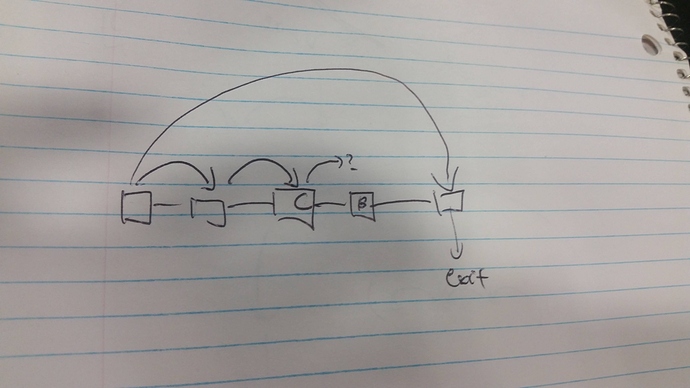The original limbo exit described at https://ethresear.ch/t/reliable-exits-of-withheld-in-flight-transactions-limbo-exits/ solves the problem that a malicious operator could force a user in certain circumstances to go through 2 exit games to withdraw his coin. However, an analogous problem appears in this situation
in which a transaction spending C comitting to inclusion in B is sent, but B is withheld. We would like to cancel the fraudulent exit. Currently C must be submitted to try to challenge the exit, and if the challenge is cancelled, the cancellation reveals that C was spent in B. In that case, the revealed child of C can be submitted to actually cancel the fraudulent exit.
We can use the same technique as limbo exits to avoid the need for two challenges. We start by viewing a limbo exit as an explicit claim that the rightful owner (ie the result of the CFCR defined by the non-limbo-exit-CFCR) is contained in a set of two directly lineal coins. We can use a similar claim in the exit game.
Here is the full game spelled out, modifying the exit game from https://ethresear.ch/t/plasma-cash-with-smaller-exit-procedure-and-a-general-approach-to-safety-proofs ; there are two possible exits. For clarity “providing a proof of a transaction” means providing a merkle proof from the transaction root of a comitted plasma block, while “providing a transaction” just means providing a digitally signed message.
Type 1 Exit
- Anyone can exit their coin by providing a proof of a transaction in their coin’s history, say C
- An exit can be challenged in three ways: i) by providing a proof of a transaction spending C, or ii) by providing a transaction C^* in the coin’s history before C, or iii) providing a proof of a transaction C^* in the coin’s history before C and a transaction T spending C^* included in a block before C
- A type (i) challenge cancels the exit immediately. a type (ii) challenge can be cancelled by providing the direct child of C^*. a type (iii) challenge can be cancelled by providing the direct child of C^* which is not the output of T, or by providing a committed transaction spending the output of T.
Type 2 Exit
- Anyone can exit their coin by providing a proof of a transaction in their coin’s history, say C, and a transaction T' spending C. A successful exit sends ether to the output of T'.
- An exit can be challenged in four ways: i) by providing a proof of a transaction different from T' spending C, or ii) by providing a transaction C^* in the coin’s history before C, or iii) providing a proof of a transaction C^* in the coin’s history before C and a transaction T spending C^* committing to a block before C, or iv) providing a committed transaction spending the output of T'.
- Same as (3) in type 1 exits; additionally, type (iv) challenge cancels the exit immediately.
